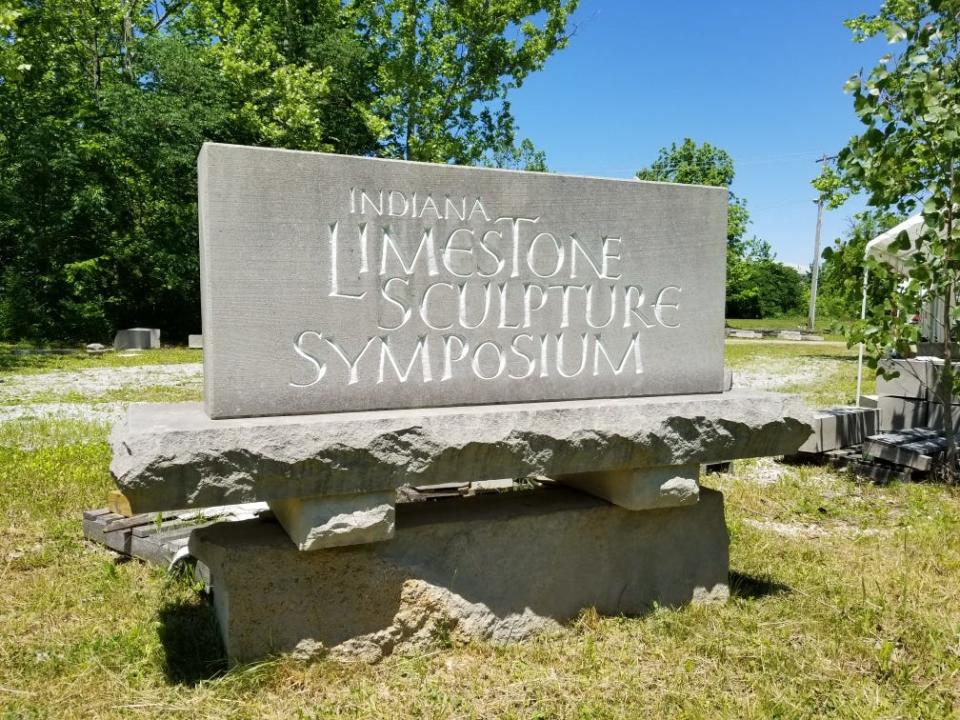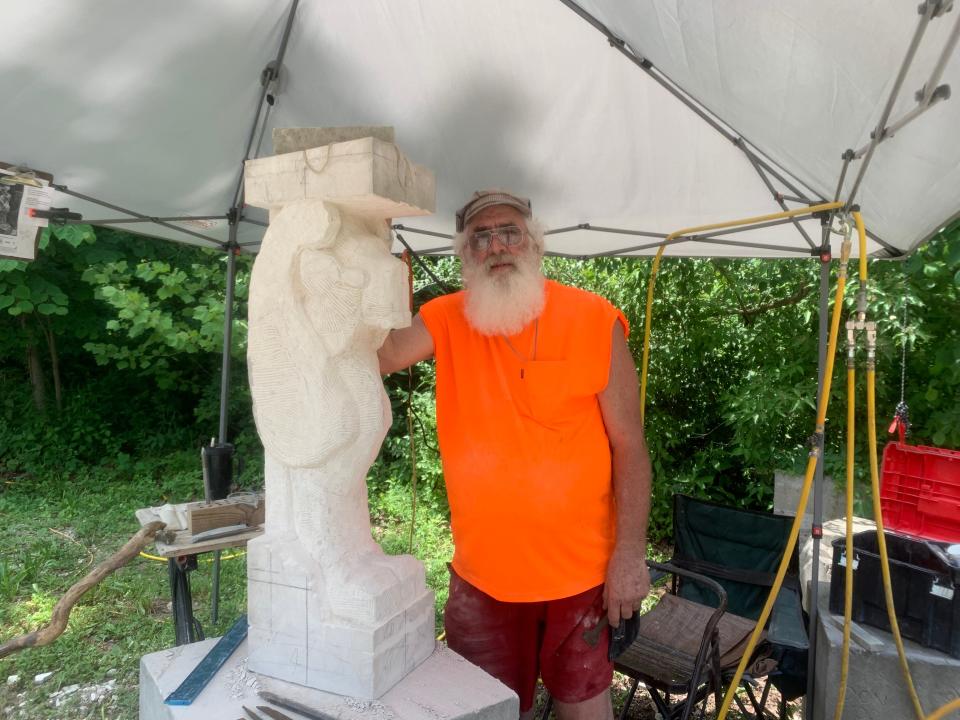Limestone Month invites experienced and new artists to learn carving skills

Carving something in stone makes it more permament than other forms of media, something participants in the Indiana Limestone Symposium know well, since many travel to Ellettsville year after year to chip away at limestone to better learn the craft.
Bill Holladay, former president of the board for the symposium, said his first limestone carving was a birdbath with medallions on the corners and the Chinese characters for winter, spring, summer and fall.
Janey Westin, one of the youth teachers from Minnesota, taught Holladay how to carve the characters. Frank Young, current president for the symposium, said Westin is talented in letter carving on the stone. She even carved a sign for the symposium.
Westin carved the majority of a Bear & Bunny Bench now on display at the Edina Community Library in Minnesota, during the symposium in 2018 and finished it at home. She started with a clay model, a tiny replica of where 2 inches represented 1 foot.

Holladay attended Indiana University for graduate school and particularly loved the carvings on IU’s campus buildings made from limestone. Holladay took a six-week introduction to stone carving class through the Bloomington Area Arts Council that got him interested in the symposium, which he has been coming to for about 20 years.
“The personnel change,” he said, “but everybody still has the same sort of camaraderie.”
As a brand new artist, Holladay said he was surprised people were willing to lend their tools and offer guidance.
“This is an amazing community,” he said.
Other possible ventures: Six places you can go hiking near Bloomington, Indiana, right now
Over time, Holladay said he’s gotten more adventurous with his work. While he said he’s slow with his work, he simply enjoys the gratification of carving. Holladay is currently carving a statue of sunflowers following his wife’s request for a piece in the garden.
“There are real artists here,” he said. “And then there are people like me who just do it for fun.”
Just what is the Indiana Limestone Symposium
The symposium is a nonprofit organization founded in 1996 that welcomes experienced artists and newcomers alike to the three weeks of learning how to carve limestone, work on sculptures and enjoy the community environment.
“We will talk you through it, we will make sure that you’re safe,” Young said. “Make sure that you’re not doing anything dangerous, make sure that you don’t hurt yourself or anybody else.”

The symposium, at 6293 Mathews Drive in Ellettsville, is on land next to the Bybee Stone Co., which provides the land and limestone for free, with a marketing benefit from the symposium.
Those wanting to participate in the symposium have to pay a tuition fee that varies depending on the classes they take and the amount of limestone carved. Attendees have access to hand carving tools, power tools and a T-shirt.
Gary Bennett, for example, paid $1,000 for his materials this year. He’s currently working on a new architectural piece that he’s never done before.
Bennett, from Oklahoma, has been coming to Indiana for the month of the symposium for a few years. He started carving wood when he was 11 years old and learned how to carve stone 13 years ago, he said, after realizing that’s what he truly enjoyed.
“You never stop learning,” he said.

Young said the symposium invites and pays artists from all over the country and world to instruct. The money from tuition pays the teachers and maintains equipment, he said, and they do have liability insurance just in case someone gets hurt.
The public is invited to watch on days when less stone is being moved and less power tools are used.
The symposium has a youth carving program that allows kids to participate. Young, an artist himself, spent two weeks of the 2021 symposium carving a “magicicada” while teaching a children’s class to show them what was possible.
Other Limestone Month events
Limestone Month, created in 2007 to celebrate the heritage and history of limestone in Monroe and Lawrence counties, is celebrated throughout June with a series of events.
Erin White, director of leisure, marketing and media for Visit Bloomington, said the Indiana Geological & Water Survey and the Lawrence County Tourism Commission partner with Visit Bloomington to organize activities like the symposium, IU campus walking tours, the Rose Hill Cemetery limestone tour and Empire Quarry tour.
Anyone can participate in the walking tours and cemetery tour for free, but must register in advance for the cemetery tour. The Empire Quarry tour is $40 and is available for those 18 and older. The Empire Quarry is where limestone was extracted to build the Empire State Building in New York City.

“This is a specific celebration that is tailored to this area, because of the lines of industry and history that exists here,” White said.
Typically, people from Monroe County and visitors interested in buildings made from limestone participate in the Limestone Month events.
“There's really no specific type of person that participates,” she said. “It's just to what we would consider to be a lifelong learner, somebody who maybe doesn't know a lot about it, but wants to learn more, or just have a deeper appreciation of how the lightsome industry has impacted our community.”
The limestone harvested from Indiana has built famous buildings across the country, White said, including the National Cathedral, the Pentagon after 9/11, the Yankee Stadium and even the Monroe County Courthouse.
Polly Sturgeon, outreach coordinator for the IGWS, said the IU campus walking tours are a one-mile loop on an accessible route through the oldest part of the campus. Sturgeon, who leads some tours, said she talks about the history of the limestone building, the geology, architectural features and hidden carvings throughout campus over the span of two hours. The schedule for walking tours can be found on the IGWS website at https://igws.indiana.edu/.
The IGWS unveiled a hands-on learning lab at the beginning of Limestone Month where visitors can interact with rock, mineral and fossil specimens, including limestone. The lab is open the public from 9 a.m. to 5 p.m. Mondays through Fridays in the Geology Building.
Sturgeon said Indiana limestone is the best building stone for three reasons: the amount of stone, its versatility and its uniformity. The beds of limestone are thick, meaning large pieces can be carved from one block. It’s durable enough to be on a building, but soft enough to have intricate designs. Finally, its uniform texture is appealing and smooth.
“There's really no other natural material from such a limited geographic area that’s made such a big impact,” she said. “So it's really special to our community. It's also impacted who we are as a community, our local heritage.”
Reach Luzane Draughon at ldraughon@gannett.com or @luzdraughon on Twitter.
This article originally appeared on The Herald-Times: Bloomington Indiana Limestone Symposium helps artists learn to carve

